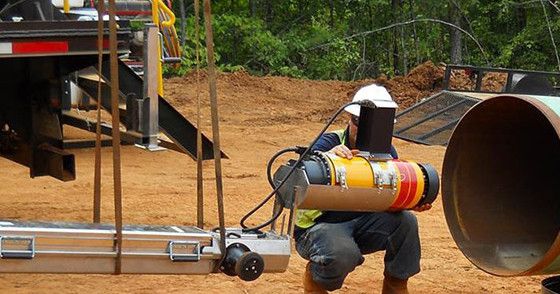Specialist Pipeline Welding Inspection Solutions: Ensuring Safety and Compliance
Comprehensive Introduction of Pipe Welding Evaluation Treatments
In the world of pipe building and construction, ensuring the integrity and safety of welded joints is critical. Pipeline welding evaluation procedures play a critical duty in assuring that bonded links fulfill rigid market requirements and specs. From careful pre-welding assessments to detailed post-weld evaluations, a well-defined evaluation process is important for maintaining the architectural soundness of pipelines. Recognizing the complexities of welding examination procedures is not just a governing need however likewise a fundamental facet of promoting the dependability of these vital facilities.
Pre-welding Assessment Preparations
Before starting the welding procedure, complete pre-welding evaluation preparations are crucial to make certain the stability and high quality of the weld joint. These preparations include a precise examination of the products to be welded, the welding equipment, and the job environment. By conducting detailed pre-welding assessment preparations, possible problems can be recognized and solved early on, leading to premium and dependable weld joints.
Welding Procedure Credentials
Extensive pre-welding inspection prep work lay the foundation for the important process of Welding Treatment Qualification, making certain the integrity and top quality of the weld joint. Welding Procedure Certification (WPQ) is a vital action in the welding procedure that involves screening and certifying welding procedures to assure they meet particular criteria and requirements. The WPQ procedure normally includes welding procedure specification growth, welding procedure certification screening, and documentation of the outcomes.
Throughout welding procedure spec growth, important information such as the welding procedure, welding products, joint design, and welding specifications are specified to develop a comprehensive procedure. Consequently, welding treatment qualification testing is conducted to verify the recommended treatment's honesty. This testing frequently includes welding examination promo codes that are subjected to various mechanical and non-destructive tests to evaluate the weld's high quality and adherence to the defined criteria.
In-process Weld Examination
Throughout the welding procedure, in-process weld examination plays an essential function in making sure the high quality and stability of the weld joint - Pipeline Welding Inspection. This sort of assessment entails checking the welding criteria, assessing the weld grain development, and detecting any potential defects or discontinuities as they occur. By performing in-process weld examinations, welding drivers can without delay resolve any kind of concerns that may arise, therefore guaranteeing and stopping more flaws that the final weld meets the called for specs
Common methods made use of for in-process weld assessment include aesthetic assessment, liquid penetrant screening, magnetic bit testing, ultrasonic screening, and radiographic testing. Visual evaluation is frequently the primary step at the same time, permitting examiners to visually examine the weld for surface abnormalities such as fractures, porosity, or insufficient combination. Much more innovative techniques like ultrasonic testing and radiographic screening provide thorough insights right into the internal framework of the weld, guaranteeing that there are no surprise problems that can jeopardize the weld joint's toughness and integrity. On the whole, in-process weld evaluation is vital for maintaining the high quality and reliability of welded pipes.
Non-destructive Screening (NDT)
Non-destructive Testing (NDT) is an important approach employed in pipeline welding assessment to weblink analyze the integrity of weld joints without triggering damage to the bonded framework. By making use of various NDT methods, examiners can examine the top quality of welds and identify any problems or interruptions that might compromise the structural soundness of the pipeline. Common NDT techniques utilized in pipe welding assessment consist of Radiographic Screening (RT), Ultrasonic Screening (UT), Magnetic Fragment Examining (MPT), Fluid Penetrant Screening (LPT), and Visual Screening (VT)
RT involves the usage of X-rays or gamma rays to create pictures of the inner structure of the weld, enabling examiners to find issues such as porosity, splits, or insufficient combination. UT utilizes high-frequency audio waves to find problems underneath the surface of the Extra resources weld, providing comprehensive information about the size and area of issues. MPT and LPT are utilized to determine surface-breaking problems by applying penetrant fluids or magnetic particles to the weld area. In addition, VT includes visual evaluation of welds to identify any kind of noticeable flaws.
Post-weld Examination and Paperwork


Documentation of post-weld examination findings is crucial for preserving quality assurance documents and ensuring conformity with industry requirements and laws. In-depth records ought to consist of information regarding the inspection techniques made use of, the location and nature of any type of defects discovered, and any kind of corrective actions taken - Pipeline Welding Inspection. Correct documentation link not only functions as a document of the weld's high quality yet also aids in future upkeep and inspection processes
Verdict

Finally, pipe welding inspection treatments play a crucial function in making certain the quality and stability of welds. From pre-welding inspections to post-weld paperwork, each action is essential in preserving the safety and security and efficiency of pipelines. By complying with well-known procedures and carrying out detailed inspections, prospective flaws can be recognized and addressed before they cause costly repair services or failings. Overall, adherence to proper assessment methods is vital to the success of pipe welding projects.
From precise pre-welding evaluations to extensive post-weld assessments, a well-defined inspection process is essential for maintaining the architectural sturdiness of pipes. By performing in-process weld assessments, welding drivers can quickly deal with any issues that might develop, consequently making certain and protecting against additional problems that the last weld fulfills the needed specifications.
Common approaches utilized for in-process weld evaluation include aesthetic evaluation, liquid penetrant screening, magnetic particle screening, ultrasonic testing, and radiographic testing.Non-destructive Screening (NDT) is a vital method utilized in pipeline welding examination to examine the integrity of weld joints without creating damage to the bonded structure. Post-weld examination includes numerous approaches to evaluate the welds for defects, consisting of aesthetic assessment, color penetrant testing, magnetic fragment testing, ultrasonic screening, and radiographic testing.